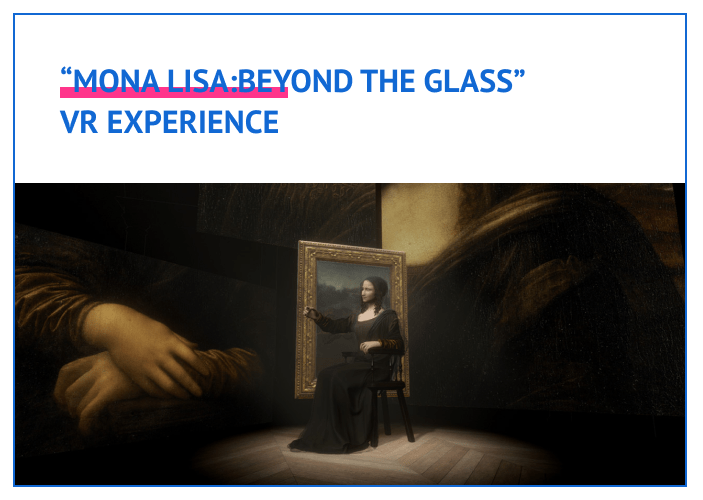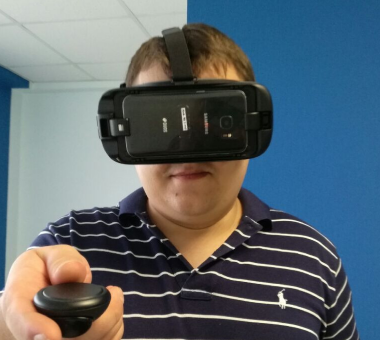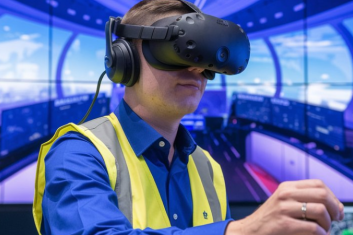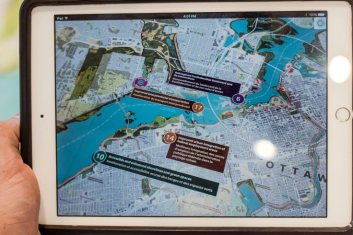Virtual Reality (VR) and Augmented Reality (AR) for museums today are not just opportunities to stand out. Custom AR/VR software is a perfect way to attract new audiences and increase interest in exhibitions. With the help of ‘virtual exhibitions,’ anyone can visit a museum, even if they are thousands of kilometers away, and admire works of art or unique ancient interiors at any time of the day.
In a modern world flooded with content, static artifacts of antiquity do not seem to be an appealing option for spending a weekend. People want the ‘WOW’ effect everywhere. VR and AR technologies make it possible to achieve such effects. Extended Reality (XR) enables the animation of exhibitions. Additionally, interactive exhibits are currently rare, which attracts a young audience that is always in search of new experiences.
Augmented Reality is used to add an overlay of data and graphic content to a real-world image. All those dreams about augmented vision, ultra-futuristic contact lenses, and cars with displays on the windscreen are based on current and future features of AR.
And Virtual Reality is a technology capable of building well-thought-out simulations rich in content, visuals, mechanics, interactivity, and so on. VR games are blowing up the market, virtual training solutions are being used across industries from healthcare to manufacturing, and the hardware is getting better and providing more and more features for force feedback and spatial navigation.
According to Bloomberg, the AR/VR market will reach $455 billion by 2030. Compare this to the same stats from 2020, when the market was valued at only $15 billion. Impressive, isn’t it?

This tremendous success comes thanks to the ability of AR/VR mobile apps to bring benefits to almost any industry. As you already know, these technologies can interrupt nearly any business.
Today, we’ll take a closer look at one such industry you may not have thought of: museums.
The digital evolution that has permeated so many aspects of our lives has come to museums as well.
Museums understand that visitors today are expecting more memorable experiences and want to gain more from each visit than ever before. A visit to the museum needs to be more engaging and emotive than it was in the past, and this is exactly where AR/VR can be utilized.
Want to build an AR/VR experience for museums or a virtual guide? We’re ready to help!HQSoftware has a team of skilled professionals ready to tackle the project. Let’s talk!
Anna Halias
Business Development Manager,
HQSoftware
Let’s review the possibilities for how these technologies can be used.
How Can Museums Use Augmented Reality?
AR technology in museums is used to provide visitors with immersive experiences inside the museum. AR can enrich everything the visitor sees and enhance the whole experience.
As a result, visitors:
- Tend to retain memories about their museum visit for longer;
- Report increased engagement in the whole experience;
- Are excited to visit the museum more than once;
- Are eager to share their experience with a larger audience on social media or by word of mouth.
Here are typical use cases for AR in museums.
AR museum experiences
Not everything can be displayed in the museum’s exhibits—there are artifacts that no longer exist on Earth.
It’s sad that we don’t have the opportunity to see some of the relics of the past because they have been destroyed or lost forever. Also, there are animals that became extinct long ago and the evidence of their existence has been reduced to bones and fossilized paw prints.
But thanks to modern technologies we can still see them—in AR!
For example, the Muséum national d’Histoire Naturelle in Paris has a Hololens-based exhibition “REVIVRE” that shows extinct animals. In AR, visitors can see animals move just as they would have appeared in their natural habitat and at full size.
Reimagination of classic art
A one-of-a-kind exhibition in Toronto at the Art Gallery of Ontario, by Alex Mayhew, was called “ReBlink.”
The creator of the exhibit reimagined some classic paintings and added modern meanings to them. Visitors can use their phones or tablets to see the paintings come alive and experience the art in a whole new way.
Art identification
AR is a versatile tool, and when combined with computer vision and image recognition technologies, it becomes an extremely powerful instrument. With AR, visitors can scan any work of art to detect what it is and learn more about the artist and the piece itself.
Galleries and museums can use AR apps to create comprehensive guides for particular exhibitions or complete galleries. This is exactly what Florence’s Uffizi Gallery did; an unofficial app scans artwork, identifies it, and provides users with an audio guide.
The list of possible applications goes on. But we have one more technology to examine, so let’s move on.
How Can Museums Use Virtual Reality?
Virtual Reality in museums is used to immerse visitors in a whole new experience, in a completely virtual world. A VR museum experience is a work of art in itself, and museums take advantage of that extensively.
For visitors, it is a:
- New and entertaining way to learn about art;
- Whole new and one-of-a-kind experience during a museum visit;
- Perfect opportunity to introduce children and skeptical adults to art and history.
The benefits of using VR in museums are tremendous; let’s see how museums have been applying it.
Reinvention of classics in VR
VR is a perfect tool to bring a breath of fresh air into classic art.
London’s Victoria and Albert Museum opened an exhibition that explored Lewis Carroll’s classic fantasy novel, Alice in Wonderland.
The playful Virtual Reality experience brings the Wonderland to life and immerses visitors in a truly interactive virtual world—exactly the one that Alice visited in her adventures.
Examining art in detail
Old paintings often carry a lot of secrets, about their meaning, their history, and the artist. In VR, all the known information can be combined in a unique experience that helps visitors understand the piece of art better and maybe even unravel some of its mysteries.
That’s exactly what the Louvre did. Its VR mobile app “Mona Lisa: Beyond the Glass” puts visitors into a virtual room with the woman DaVinci painted—Lisa Gherardini—as if she was alive right now.

Interaction with art
Traditionally, art is something you enjoy by observing. There’s not much opportunity to interact with it—you go to a museum, read captions, listen to the art historian’s lecture, and on average that’s it.
Now, there are VR use cases in museums when visitors can actually interact with the exhibits. In Los Angeles, the Peterson Automotive Museum partnered with Microsoft HoloLens to build a VR experience. Using it, visitors can interact with a classic sports car, the Ford GT40.
All these use cases bring unmatched benefits for museums. Read on to learn more.
Benefits of Using AR/VR in Museums
AR/VR mobile apps help museums to solve various tasks and to benefit from these modern technologies in many ways.
Expanding target audience
AR technology in museums as well as VR apps can attract a new audience that wasn’t particularly interested in art and history before.
How do modern businesses use AR to increase their revenues and outperform their industry competitors?

AR/VR technologies are themselves an attraction, and when paired with art and interesting exhibitions the effect rises significantly.
Enriched museum experiences
One of the greatest benefits of using VR in museums is that any exhibit can be turned into an exciting simulation with 3D content, interactive communication with the audience, and more.
Reaching new levels of interaction with visitors
As already mentioned, AR/VR technologies in museums allow for better interactivity, an important benefit.
The more interactive the experience, the more engaged and entertained users are, and this results in overall museum visits being much more exciting and interesting.
Creating additional revenue streams
Needless to say, virtual tour guides, VR exhibitions, and AR apps for museums are great tools for boosting revenue.
Create an interactive tour guide and sell it in mobile app stores, build a virtual experience to accompany an exhibition, or turn the whole exhibition into a virtual experience—the opportunities for new revenue streams are endless!
But where there are benefits, there are challenges as well. Let’s take a closer look.
Challenges Museums Face Using AR/VR
We have highlighted three main challenges for museums that want to or already apply AR/VR.
AR/VR solutions can be expensive to build
This is truly a limiting factor for most museums.
For VR use cases in museums, buying headsets for visitors alone is pretty expensive, and we haven’t even started talking about development costs. Depending on the size of the project, technical requirements for the experience, and the amount of immersive content required, the costs can vary from $10,000 to $50,000. They’re limited only by the customer’s imagination.
AR is definitely cheaper—most solutions can be developed for smartphones and tablets that users already have. But museums still have to develop and update the content.
Despite the expense of building AR and VR apps, it is a huge revenue channel for museums that will pay for itself fairly quickly.
Museums are concerned that AR/VR experiences will replace physical facilities
Some museums worry that if they provide users with VR or AR experiences, they will lose interest in traditional art and exhibits and stop visiting museums at all.
But the goal of utilizing AR/VR apps for museums is exactly the opposite—to attract new visitors, ensure everyone is interested in the exhibit since it has become more interactive, and attract kids and adults who have lost interest in art and history.
To appeal to those who aren’t much interested in museums in the first place, there is also an option—offer remote VR mobile apps and AR solutions to turn their home space into an exhibition.
Visitors get uncomfortable in simulations
The disconnect between the visitor’s physical body and the virtual world can cause some unpleasant symptoms, such as headache, dizziness and eyestrain.
Yet, with the development of hardware and enhancements in screen resolution and quality, we will probably see these issues diminish.
And all these drawbacks can’t stop immersive experiences from shaping the future of museums.
Future of AR/VR in Museums
AR mobile apps and VR use cases in museums suggest that museums in future will be no stranger to the disruptive influence of digital technologies.
There are already many applications for museums, from virtual tour guides to whole exhibitions in VR.
Some may hesitate, arguing that this technological revolution means a surrender of culture to tech.
But we think the implementation of VR and AR in museums is not about replacing old traditions but about complementing them with more information and interactivity, to attract more people.
It is clear that the future of museums lies in the field of immersive technologies. To stay relevant and cater to the desires of technophile audiences, museums should embrace AR/VR and what these technologies have to offer.
Interested in building a virtual tour guide or immersive art? Contact us to learn more about our AR/VR services for museums.

AR/VR Expert
A developer with extensive expertise in AR/VR, very ingrained into the topic of Mixed Reality development. Shares his knowledge and the results of many years of work.
Get Your VR Prototype For Free
Visit PageRelated Posts
View AllFrequently Asked Questions
What are the best examples of museums using AR?
What are the best examples of museums using VR?
How much does it cost to build an AR/VR app?
We are open to seeing your business needs and determining the best solution. Complete this form, and receive a free personalized proposal from your dedicated manager.

Sergei Vardomatski
Founder







